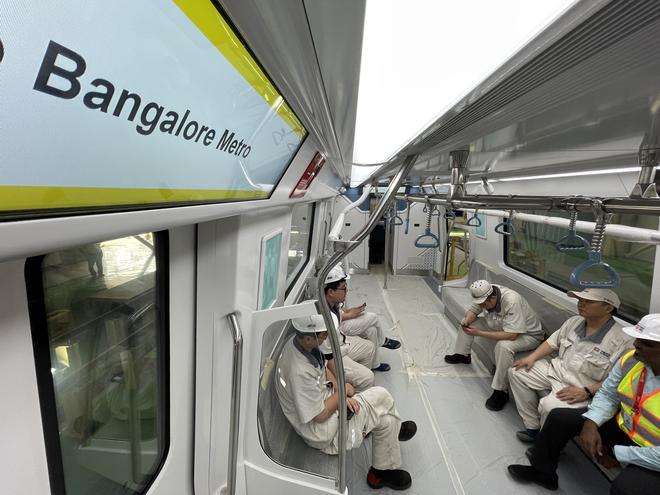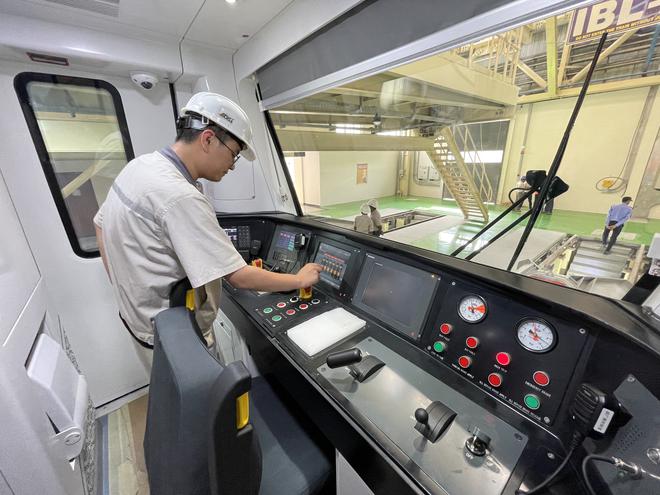The Story so far
On February 14, the Bengaluru Metro Rail Corporation Limited (BMRCL) received the first set of six train coaches, which arrived at the Hebbagodi metro depot from China and are now undergoing multiple tests.
The inaugural driverless prototype train for Bengaluru Metro’s upcoming Yellow Line, a 19 km route linking R.V. Road to Bommasandra near Electronics City, is anticipated to be operational by the end of this year.
What are driverless trains
The introduction of driverless trains on Bengaluru Metro’s Yellow Line is part of the Communication-Based Train Control (CBTC) signalling system, also referred to as ‘driverless technology.’ This marks the first implementation of such technology on the Bengaluru metro.
Presently, Namma Metro utilizes the DTG (distance-to-go) signalling system. According to BMRCL officials, the implementation of CBTC will significantly decrease headway from the current two and a half minutes to as low as 90 seconds. While the trains are capable of autonomous operation, the BMRCL plans to deploy locomotive pilots to operate them initially.
Who is supplying coaches
The China Railway Rolling Stock Corporation (CRRC) factory in China obtained a ₹1,578-crore contract in 2019 to deliver 216 metro coaches to BMRCL. However, they were unable to fulfil the contract owing to not having established a manufacturing plant in India as stipulated.
This delayed the supply of metro trains to BMRCL. Earlier, the BMRCL had issued several notices to the CRRC, contemplating the encashment of its ₹372-crore bank guarantee. Presently, the Chinese company has partnered with Kolkata-based Titagarh Wagons to supply the remaining coaches.
“Besides, Prototype Train for CBTC, one more prototype train with DTG Signalling is being supplied by CRRC, China. Balance 34 Train Sets (14 CBTC & 20 DTG) are manufactured in India at Titagarh Rail Systems Limited in West Bengal,” BMRCL official said.

Tests BMRCL is conducting
Before commencing its first commercial operations, driverless trains undergo a wide range of about 37 tests, which may take four months, followed by system integration with a signalling system, telecommunications system, power supply system, etc., and tests for 45 days.
“Being new rolling stock, multiple tests need to be conducted. The coaches have been assembled before moving to the test track for static and electrical circuit testing. Later, they will be moved to mainline testing,” said Jithendra Jha, project manager, Rolling Stock, BMRCL.
“The statutory safety tests shall include Oscillation Trials by the Research Designs and Standards Organisation (RDSO) and inspection by the Commissioner of Metro Rail Safety (CMRS). Based on the recommendations of RDSO and CMRS, approval of Railway Board to be obtained for introducing the trains for revenue service,” he added.
Features of the trains
According to BMRCL, this train is equipped with state-of-the-art technology, such as Unattended Train Operations (UTO), Enhanced Supervision Capability from Operations Control Centre(OCC), Track Monitoring System, Hot Axle Detection System, Obstacle and Derailment Detection System, etc. The coaches also have electric signage above the doors to showcase routes, advertisements, notices, information, etc.
Officials said that these trains are equipped with a dynamic route map indicator, offering real-time location information to passengers during their journey. The trains will have Automatic axle box temperature monitoring which will be incorporated into both CRRC’s CBTC and DTG trains, officials explained.
“The side indicator allows the reservation of any coach for women where currently only the first coach of the train is reserved for women. Additionally, the automatic track monitoring feature will be deployed in two trains. One of these trains can function as a pilot, and the track monitoring system will autonomously assess the track condition. In the event of any issues, it will generate alerts using Artificial Intelligence (AI) software. The system is equipped with a camera-based setup, sending track images to the server,” official added.
In these trains, advertisements displayed on board can be automatically uploaded from the Operations Control Center (OCC) instead of relying on manual uploads. Additionally, passenger alarm buttons are incorporated, enabling distressed passengers to contact the OCC for assistance during their metro ride.

Why have drivers initially
BMRCL officials said that the initial phase of commercial service will involve drivers. Following this, BMRCL will conduct tests for driverless operation.
“The transition to commercial service in the driverless mode is contingent upon approval from the Commissioner of Metro Railway Safety (CMRS). Currently, BMRCL operates trains, where the trains autonomously travel between stations, and drivers handle tasks such as door operations, obstacle detection on tracks, and manage train operations during disruptions,” a official explained.
According to BMRCL, the driverless train undergoes an automatic self-check regularly. Each morning, the train initiates its services with an early ‘wake-up’ command received from the Operations Control Centre (OCC). This command triggers the activation of interior lights and starts the engine of the train. Afterward, an automatic self-check ensures the technical soundness of the train before proceeding to automated washing plants for cleaning. Following the cleaning process, the train proceeds to the platforms for commercial services. During the night, the train enters ‘sleep mode’.
Inspiration for train design
The design of these driverless trains draws inspiration from two iconic symbols of Karnataka - the mythological two-headed bird in the state emblem, ‘Gandaberunda’, and the ‘Lalbagh glass house’ of Bengaluru, influencing their exterior design.
“We explored various designs that would be connected to Karnataka’s identity and ultimately settled on these two,” said Jha.
Gandaberunda, the mythical two-headed bird, is often seen as one of Lord Vishnu’s many incarnations in Hindu mythology. Originally used by the Mysore Kingdom and subsequently by the Mysuru state after independence, it has persisted as the state emblem even after Mysuru state became Karnataka 50 years ago.
The Lalbagh Glass House in Bengaluru, inspired by London’s Crystal Palace, stands as the primary attraction in the city and serves as the venue for hosting flower shows.
“The appearance of the glass house’s facade has been incorporated into the train exterior, while a design resembling the tail feathers of the Gandaberunda has been integrated into the trains’ couplers,” Jha explained.
What is Yellow Line
The 18.82-km-long under-construction metro line connects R.V. Road with Bommasandra is Bengaluru metro’s yellow line. It is a fully elevated metro route with 16 stations. It connects with the Green Line of Bengaluru Metro at R.V. Road Station and with the Pink Line at Jayadeva Hospital Station.
This line has a metro-cum-road flyover from Ragi Gudda to Central Silk Board, which is 3.13 km long and was built to decongest Central Silk Board Junction. It consists of five Loops and Ramps, which are extensions of the double-decker flyover towards K.R. Pura and Hosur road, which are in advanced stages of construction.
The line comprises a completely elevated metro route featuring 16 stations: Rashtriya Vidyalaya Road, Raggigudda, Jayadeva Hospital, BTM layout, Central Silk Board, Bommanahalli, Hongasandra, Kudlu Gate, Singasandra, Hosa Road, Beratena Agrahara, Electronics City, Infosys Foundation Konnappana Agrahara, Huskur Road, Biocon—Hebbagodi, and Bommasandra.
Officials said, “The Jayadeva Metro Station stands as an iconic interchange hub designed to seamlessly integrate the Yellow Line (R V. Road to Bommasandra) Reach 5 and the Pink Line Reach 6 (Kalena Agrahara to Nagawara).”
This integration involves various components, including the Bannerghatta Road underpass, Mareanahalli Road at ground level, Raggigudda - CSB Road flyover, Metro Concourse level, Reach 5 platform for the Yellow line (RV Road to Bommasandra), and Reach 6 platform for the Pink line (Kalena Agrahara-Nagawara). “This station serves as a pivotal point connecting different metro lines and facilitating efficient transit between them,” officials added.
How connectivity will get better
The primary objective of the Yellow Line is to enhance connectivity to regions housing major companies such as Infosys and Biocon, as well as to South Bengaluru.
“This line is poised to alleviate the daily challenges faced by Bengaluru’s metro commuters to a significant extent. Moreover, it will augment the overall metro connectivity in the city, contributing to a more convenient and efficient commuting experience. The commissioning of this line is expected to profoundly impact the lives of Bengaluru’s metro commuters, providing them with a more comfortable experience and efficient service. Additionally, Bengaluru Metros will become the second in the country to feature driverless trains,” official added.







